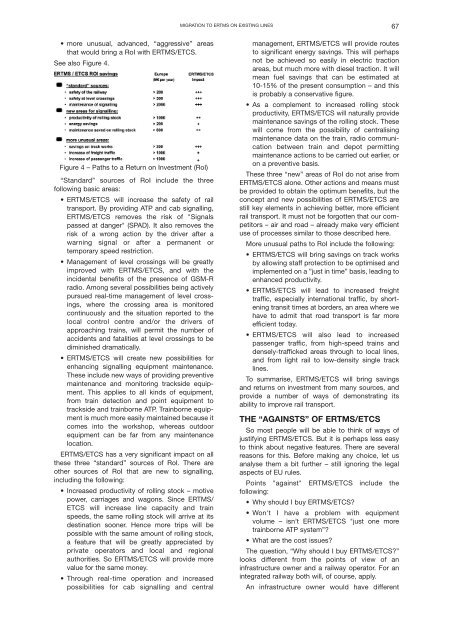Proceedings 2002/2003 - IRSE
Proceedings 2002/2003 - IRSE
Proceedings 2002/2003 - IRSE
You also want an ePaper? Increase the reach of your titles
YUMPU automatically turns print PDFs into web optimized ePapers that Google loves.
MIGRATION TO ERTMS ON EXISTING LINES 67<br />
• more unusual, advanced, “aggressive” areas<br />
that would bring a RoI with ERTMS/ETCS.<br />
See also Figure 4.<br />
Figure 4 – Paths to a Return on Investment (RoI)<br />
“Standard” sources of RoI include the three<br />
following basic areas:<br />
• ERTMS/ETCS will increase the safety of rail<br />
transport. By providing ATP and cab signalling,<br />
ERTMS/ETCS removes the risk of "Signals<br />
passed at danger" (SPAD). It also removes the<br />
risk of a wrong action by the driver after a<br />
warning signal or after a permanent or<br />
temporary speed restriction.<br />
• Management of level crossings will be greatly<br />
improved with ERTMS/ETCS, and with the<br />
incidental benefits of the presence of GSM-R<br />
radio. Among several possibilities being actively<br />
pursued real-time management of level crossings,<br />
where the crossing area is monitored<br />
continuously and the situation reported to the<br />
local control centre and/or the drivers of<br />
approaching trains, will permit the number of<br />
accidents and fatalities at level crossings to be<br />
diminished dramatically.<br />
• ERTMS/ETCS will create new possibilities for<br />
enhancing signalling equipment maintenance.<br />
These include new ways of providing preventive<br />
maintenance and monitoring trackside equipment.<br />
This applies to all kinds of equipment,<br />
from train detection and point equipment to<br />
trackside and trainborne ATP. Trainborne equipment<br />
is much more easily maintained because it<br />
comes into the workshop, whereas outdoor<br />
equipment can be far from any maintenance<br />
location.<br />
ERTMS/ETCS has a very significant impact on all<br />
these three “standard” sources of RoI. There are<br />
other sources of RoI that are new to signalling,<br />
including the following:<br />
• Increased productivity of rolling stock – motive<br />
power, carriages and wagons. Since ERTMS/<br />
ETCS will increase line capacity and train<br />
speeds, the same rolling stock will arrive at its<br />
destination sooner. Hence more trips will be<br />
possible with the same amount of rolling stock,<br />
a feature that will be greatly appreciated by<br />
private operators and local and regional<br />
authorities. So ERTMS/ETCS will provide more<br />
value for the same money.<br />
• Through real-time operation and increased<br />
possibilities for cab signalling and central<br />
management, ERTMS/ETCS will provide routes<br />
to significant energy savings. This will perhaps<br />
not be achieved so easily in electric traction<br />
areas, but much more with diesel traction. It will<br />
mean fuel savings that can be estimated at<br />
10-15% of the present consumption – and this<br />
is probably a conservative figure.<br />
• As a complement to increased rolling stock<br />
productivity, ERTMS/ETCS will naturally provide<br />
maintenance savings of the rolling stock. These<br />
will come from the possibility of centralising<br />
maintenance data on the train, radio communication<br />
between train and depot permitting<br />
maintenance actions to be carried out earlier, or<br />
on a preventive basis.<br />
These three “new” areas of RoI do not arise from<br />
ERTMS/ETCS alone. Other actions and means must<br />
be provided to obtain the optimum benefits, but the<br />
concept and new possibilities of ERTMS/ETCS are<br />
still key elements in achieving better, more efficient<br />
rail transport. It must not be forgotten that our competitors<br />
– air and road – already make very efficient<br />
use of processes similar to those described here.<br />
More unusual paths to RoI include the following:<br />
• ERTMS/ETCS will bring savings on track works<br />
by allowing staff protection to be optimised and<br />
implemented on a ”just in time” basis, leading to<br />
enhanced productivity.<br />
• ERTMS/ETCS will lead to increased freight<br />
traffic, especially international traffic, by shortening<br />
transit times at borders, an area where we<br />
have to admit that road transport is far more<br />
efficient today.<br />
• ERTMS/ETCS will also lead to increased<br />
passenger traffic, from high-speed trains and<br />
densely-trafficked areas through to local lines,<br />
and from light rail to low-density single track<br />
lines.<br />
To summarise, ERTMS/ETCS will bring savings<br />
and returns on investment from many sources, and<br />
provide a number of ways of demonstrating its<br />
ability to improve rail transport.<br />
THE “AGAINSTS” OF ERTMS/ETCS<br />
So most people will be able to think of ways of<br />
justifying ERTMS/ETCS. But it is perhaps less easy<br />
to think about negative features. There are several<br />
reasons for this. Before making any choice, let us<br />
analyse them a bit further – still ignoring the legal<br />
aspects of EU rules.<br />
Points "against" ERTMS/ETCS include the<br />
following:<br />
• Why should I buy ERTMS/ETCS?<br />
• Won't I have a problem with equipment<br />
volume – isn’t ERTMS/ETCS "just one more<br />
trainborne ATP system”?<br />
• What are the cost issues?<br />
The question, “Why should I buy ERTMS/ETCS?”<br />
looks different from the points of view of an<br />
infrastructure owner and a railway operator. For an<br />
integrated railway both will, of course, apply.<br />
An infrastructure owner would have different

















